GENESIS64 licensing uses the WCF Service as the standard communication method for determining if an application is running and checking its validity to run against the License Monitor service. When a client is closed, or should a client session terminate in any other manner the licensing service reclaims any license in use and restores it to the available license count so that it can be used for another client. When you purchase licenses for an application you are purchasing a license for client access to that specific application.
Licensing is based on two measurable factors:
Availability of application
Availability of features
When you purchase a license your license entitles you to run what is called a feature, and is one of the following instances:
A client can run as a desktop application (e.g., GraphWorX64 )
Sets the number of unique machine accounts, either client or server, that ICONICS applications can be run on
Access local I/O which determines the number of FrameWorX64 servers that can be run.
Allows a user to configure ICONICS applications, in four categories: Workbench , GraphWorX64 , AlarmWorX64 , and Hyper Historian .
GENESIS64 uses a hardware key that is self-contained that manages your license point count. When you insert the USB key into the system, the key contains the drivers that the Windows operating system needs to access the licenses, and those drivers are automatically installed. A light on the USB key indicates that the key is working. For additional information, refer to the Using the ICONICS Web Licensing Utility for Hardware Key License topic.
The software key is a licensing key that resides on the hard drive of a specific computer. Each software key is used on a single, specific computer and is used only once. It is activated using a key code that is tied to the computer that is being licensed; this process is described below in Activating a Software License. For additional information, refer to the Using the ICONICS Web Licensing Utility for Software Key License topic.
When you purchase licenses the licenses are measured in a point count that determines the number of OPC tags that you can use in your application. One point count is used for most GENESIS64 applications, the exception being the Hyper Historian which has its own point count system. There are two different modes for using tags in point counts:
On-demand mode. You can dynamically use and reuse points as needed. The count at any instance includes active points only.
Configure mode. All points are statically configured in a static central location, inside the Unified Data Manager . All configured points are counted against the point count.
These two mode types are not interchangeable and require you to buy a new license to upgrade your existing license status.
The ICONICS applications that have license monitoring include:
Workbench
GraphWorX64
TrendWorX64 Viewer
AlarmWorX64 Viewer
EarthWorX64
Gadgets
TrendWorX64 Logger
AlarmWorX64 Logger
AlarmWorX64 Server
Hyper Historian Standard
Hyper Historian Enterprise
If you see a screen with a key motif for its background, a licensing error conditions exists. An alert describes the error. If your license expires for a particular feature, an alert tells you that you are "Disabled and Out-of-License". If an application cannot make a connection to its server it will post a warning describing which server cannot be accessed.
For more information, refer to these topics:
Return to Top
Before you can use a computer to use an ICONICS product, you must have a license agreement with ICONICS and activate the software license on the computer. Each computer has its own license key.
To activate a software license, follow these steps:
From the Windows Start menu/screen, type License Utility. The Software License Activation dialog box appears.
A Site Code appears in the dialog box. You must go to the ICONICS web site and enter this code in order to receive a site key and license file from ICONICS.
You will receive a Site Key and License File from ICONICS. Enter those into the fields.
|
|
Note: If you haven't yet received a site key and license file from ICONICS or you are waiting for a new license from ICONICS, you can click the Activate Trial License button to activate a temporary license that will last for 30 days without having to contact ICONICS. You can also use this feature if your hardware or software license stops working. This temporary license can be used only once per computer. When you receive your site key and license file, you can return to these steps to active the software license on the computer. |
Click the Activate License button. The software license is activated on the computer.
Return to Top
A software license is valid for one computer and one computer alone. Over time you may need to replace a computer and move its license to another computer. Follow these steps for transferring a computer's software license to another computer; for additional information, refer to the Using the ICONICS Web Licensing Utility to Transfer a License topic.
On the computer that you are decommissioning, follow these steps:
From the Windows Start menu/screen, type License Utility. The Software License Activation dialog box appears.
Make a record of the software license information (press Alt + Print Screen to capture the License Utility tool, then paste the image into a file that you save). Note that this step is optional, but it gives you a record of your license before moving forward.
Click the Kill Current License button. This writes a kill code .TXT to the desktop for you to provide to ICONICS as proof that the license has been killed.
Make a record of the kill code and save it with your captured license information. Save the kill code .TXT file in a safe location.
Contact ICONICS to provide the kill code for the license. When you receive confirmation from ICONICS, proceed with the rest of the transfer of the license.
On the computer you are transferring the license to, follow these steps:
From the Windows Start menu/screen, type License Utility. The Software License Activation dialog box appears.
Referring to your captured license information, enter the software license a Site Key and License File.
Click the Activate License button. The software license is re-activated on the new computer.
Return to Top
If a license stops working, you can activate the temporary license while you are trying to fix the problem. You can activate this license without contacting ICONICS. The license lasts for 30 days. It can be used only once on a computer, so use it only when you absolutely have to.
To activate the temporary license:
From the Windows Start menu/screen, type License Utility. The Software License Activation Utility dialog box appears.
Click the Activate Trial License button. The temporary software license is activated on the computer for 30 days.
Return to Top
You can monitor your license status using the MonitorWorX Viewer, which is a special configuration of the MonitorWorX utility. Use the MonitorWorX Viewer to see the status of ICONICS products installed at your company. To open MonitorWorX, go to the Start menu/screen and enter MonitorWorX Viewer.
MonitorWorX opens the MonitorWorX Viewer and displays the Licensing tab and the Overview sub-tab on top. Each of the MonitorWorX Viewer sub-tabs of the Licensing tab (Overview, GENESIS64, Data Connectors, AnalytiX, AlarmWorX Multimedia, and Diagnostics) is illustrated and described below. For additional help using this tool, refer to Reviewing Your Licensing, below.
Return to Top
The Overview tab displays the nature of your license (whether it is a demonstration license or a paid license), and how the tags are configured.
Overview Tab in License Viewer
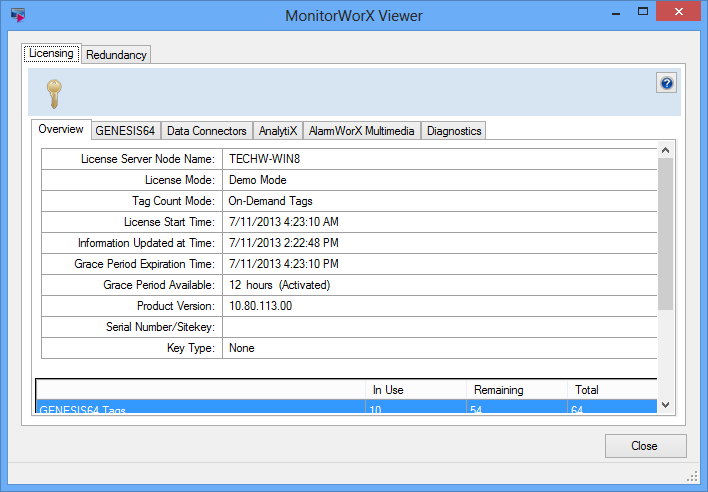
The tab lists the following information:
License Server Node Name: The name of the node where the license you are using is installed. ICONICS products use a centralized licensing system; if you are experiencing licensing issues, make sure that this is the correct machine for your client to be pointing to and consider whether there is different server that holds the license for your client.
License Mode: A description of the license in use on the server. License modes are:
Demo Mode is a trial license that gives you a brief length of time to use ICONICS products. When Demo Mode displays in red, the Demo Mode license in use on the server has expired, and the product no longer runs on the server. Please contact ICONICS Technical Support to obtain a valid license.
Valid License means that a valid, working license is in use on the server; the product can be used inside the terms displayed on this tab and the other tabs in the License Monitor.
License Failing means that the valid license in use on the server has expired or has unexpectedly terminated; the grace period is now in effect. There are a few steps you can take to find the cause of this status. If the time displayed in the License Expiration Time has passed, then the license expired; please contact ICONICS Technical Support to renew or obtain a valid license. However, if the License Expiration Time has not passed, make sure the license key was not removed from the server; if it was removed, replacing it inside the grace period specified in the Emergency License Extension will restore your license. If the key is damaged or broken, please contact ICONICS Technical Support immediately to replace it inside the grace period displayed in the Grace Period Available field.
License Failed indicates that the grace period displayed in the Emergency License Extension field has passed. The product cannot be used. Please contact ICONICS Technical Support to restore or renew your license.
Tag Count Mode: Indicates how licensing for OPC tag usage is configured.
License Start Time: The time at which the license's use on the server began. The start time is especially important if you are in Demo Mode, which limits the time of use.
Information Updated at Time: The time at which the information displayed in the License Monitor was last updated. Information is updated roughly every 10 minutes. All In Use and Remaining columns contain counts that were current at the time displayed in this field.
Grace Period Expiration Time: The time at which the license in use on the server goes into License Failing status (see the License Mode field description above). If UNLIMITED displays, the license will not expire.
Grace Period Available: The length of the expiration grace period for the license; for example, 12 hours or 5 days. The grace period begins as soon as the license expires or terminates unexpectedly. (Always bear in mind that the license can terminate unexpectedly, for example, if the license key becomes damaged or broken.) Once you enter this grace period, it is critical that you reestablish your license before the grace period ends. When the grace period ends, the product stops running. Reestablishing your license can be as simple as restoring a removed key; however, it may require you to contact ICONICS Technical Support to renew your license or get a new key.
Product Version: Provides the release version number for the installation of ICONICS software.
Key Type: Displays Software Key or Hardware Key. None indicates you are using a demo license. The parenthesized text next to it indicates Unlimited or Time-Limited.
The In Use and Remaining columns contain counts that were current at the time displayed in the Information Updated at Time field. It is possible that connections have been added or removed since then.
GENESIS64 Tags: The In Use column shows the number of I/O points (that is, OPC tags) that are currently in use. The Remaining column shows the additional number that the license allows for. And the Total column shows the total number of I/O points allowed for this use per ICONICS license agreement. Note that this count applies to unique I/O usage; even if multiple process points share an I/O point, the I/O point is counted once in this total.
HyperHistorian Tags: The In Use column shows the number of I/O points (that is, OPC tags) that are currently logging data through HyperHistorian on the server. The Remaining column shows the number of additional HyperHistorian tags that the license allows for. And the Total column shows the total number allowed for this use per the ICONICS license agreement.
GENESIS64 Application Stations: The In Use column shows the number of workstations where GENESIS64 is currently running as an application. The Remaining column shows the number of additional workstations that the license allows for the same purpose. And the Total column shows the total number of workstations allowed for this use per the ICONICS license agreement.
Desktop Stations: The In Use column shows the number of workstations where the product is currently running as a desktop application. The Remaining column shows the number of additional workstations that the license allows for the same purpose. And the Total column shows the total number of workstations allowed for this use per the ICONICS license agreement.
Client Stations: The In Use column shows the current number of workstations where an operator is connected to the desktop application as a client. The Remaining column shows the number of additional workstations that the license allows for the same purpose. And the Total column shows the total number of workstations allowed for this use per the ICONICS license agreement.
Local IO Access Stations: The In Use column shows the number of workstations currently being used for local I/O access. The Remaining column shows the number of additional workstations that the license allows for the same purpose. And the Total column shows the total number of workstations allowed for this use per the ICONICS license agreement.
To see the machines where a feature or product is in use, use the Diagnostics tab.
Return to Top
The GENESIS64 tab, illustrated below, lists license information for each GENESIS64 feature that is individually licensed.
GENESIS64 Tab in License Monitor
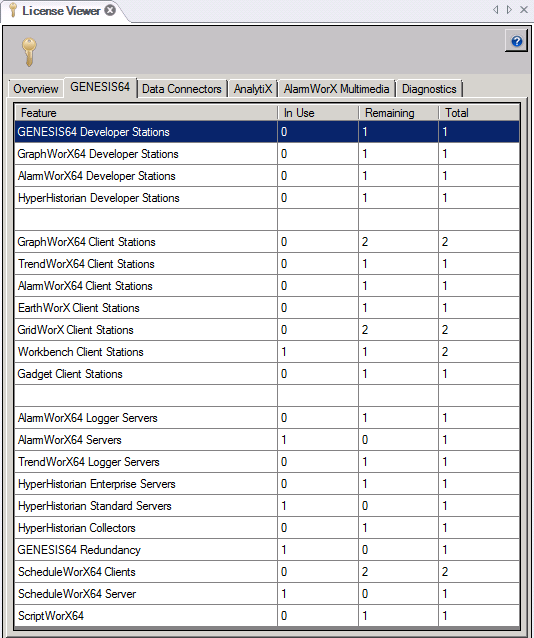
The In Use column displays the number of workstations where the GENESIS64 feature is currently running. The Remaining column displays the number of additional workstations that can run the feature in accordance with the license. The Total column displays the number of workstations that can run the feature per the ICONICS license agreement. Note that In Use and Remaining columns contain counts that were current at the time displayed in the Information Updated at Time field on the Overview tab; it is possible that connections have been added or removed since then.
To see the machines where a GENESIS64 feature is in use, use the Diagnostics tab.
Return to Top
The Data Connectors tab, illustrated below, lists license information for each data connector that is individually licensed.
The Data Connectors Tab
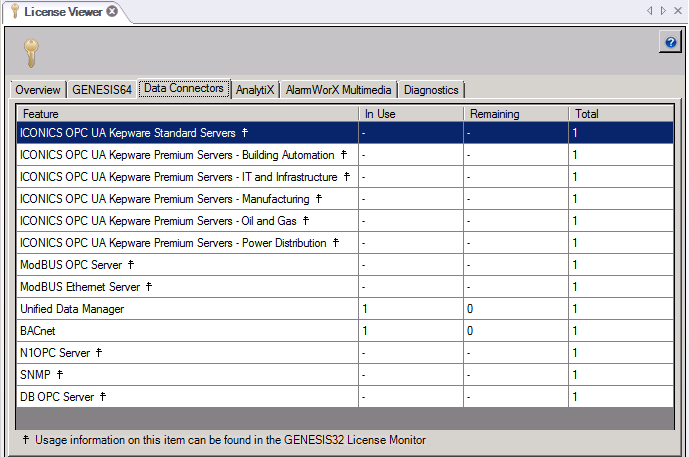
The In Use column displays the number of workstations where the feature is currently running. The Remaining column displays the number of additional workstations that can run the feature in accordance with the license. The Total column displays the number of workstations that can run the feature per the ICONICS license agreement. Note that In Use and Remaining columns contain counts that were current at the time displayed in the Information Updated at Time field on the Overview tab; it is possible that connections have been added or removed since then.
To see the machines where a feature is in use, use the Diagnostics tab, described just below.
Return to Top
The AnalytiX tab, illustrated below, lists license information for each ICONICS AnalytiX feature that is individually licensed.
The AnalytiX Tab

The In Use column displays the number of workstations where the AnalytiX feature is currently running. The Remaining column displays the number of additional workstations that can run the feature in accordance with the license. The Total column displays the number of workstations that can run the feature per the ICONICS license agreement. Note that In Use and Remaining columns contain counts that were current at the time displayed in the Information Updated at Time field on the Overview tab; it is possible that connections have been added or removed since then.
Return to Top
The AlarmWorX Multimedia tab, illustrated below, lists license information for each AlarmWorX Multimedia feature that is individually licensed.
The AlarmWorX Multimedia Tab
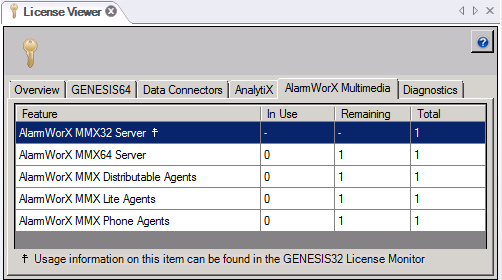
The In Use column displays the number of workstations where the AlarmWorX Multimedia feature is currently running. The Remaining column displays the number of additional workstations that can run the feature in accordance with the license. The Total column displays the number of workstations that can run the feature per the ICONICS license agreement. Note that In Use and Remaining columns contain counts that were current at the time displayed in the Information Updated at Time field on the Overview tab; it is possible that connections have been added or removed since then.
Return to Top
The Diagnostics tab, illustrated below, lists the ICONICS application features that are currently running, and the node where each is running. Any node that is running a licensed feature while pointing to the licensed server is included in the list. Use this tab to locate the nodes that are consuming license counts for this server's license.
The Diagnostics Tab
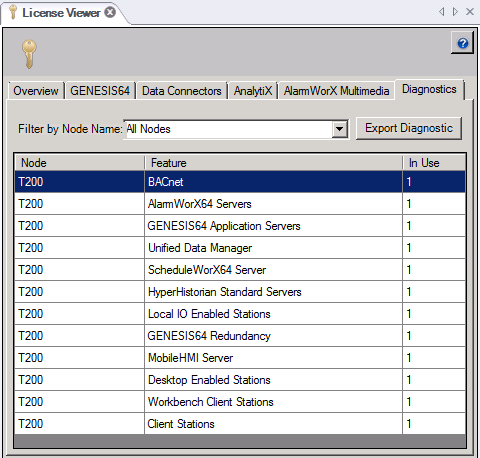
You can use the Filter by Node Name drop-down list to isolate the listing to just one node. Clicking the Export Diagnostic button opens a dialog box you can use for saving a diagnostic log file; you can email the log file to ICONICS Technical Support for help diagnosing your licensing issue.
Node: The name of the node where a feature is running. To list just one node, select the node from the Filter by Node Name drop-down list.
Feature: The ICONICS feature that is currently in use on the node.
In Use: The number of workstations running the feature that are connected to the server node. Note that this column contains counts that were current at the time displayed in the Information Updated at Time field on the Overview tab; it is possible that connections have been added or removed since then.
Return to Top
At any time, you can use the License Monitor to review the license status of ICONICS products installed at your company. You can access the License Monitor in either of the following ways:
From the Start menu, click Start > All Programs > ICONICS Licensing > ICONICS .NET Licensing > License Viewer.
From within the Workbench, go to the Tools ribbon and click the Licensing button.
From within the Workbench, from the File menu, select Tools, then Licensing.
The License Monitor, Displayed in the Workbench where GraphWorX64 is Running
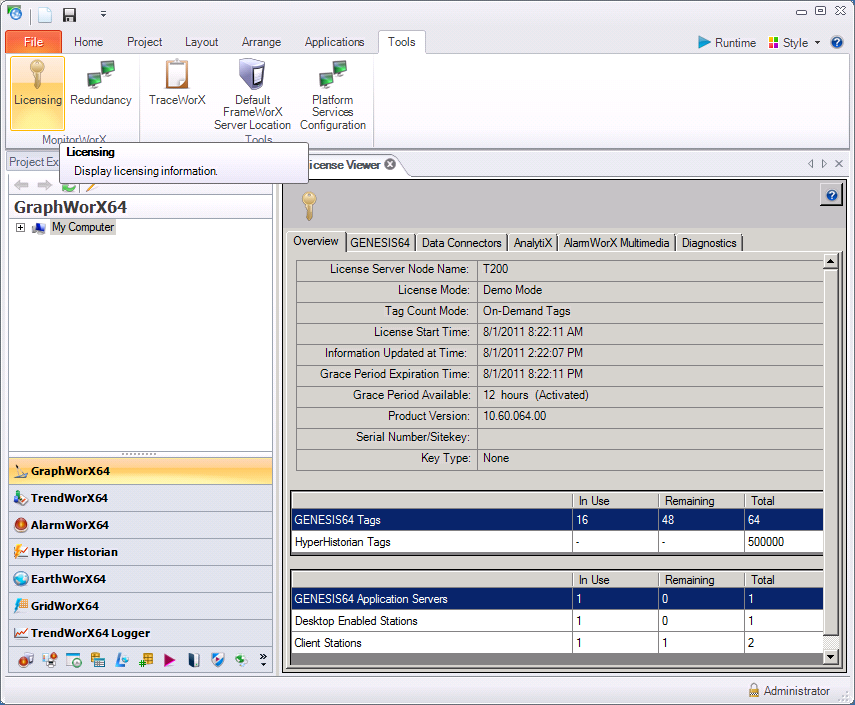
The tab that displays initially is the Overview tab, where you can see general information about the license for the server that the node points to. You can view license information for GENESIS64 , AnalytiX, and OPC Servers product features by using the tabs for those products. To locate the nodes where individual product features are consuming the server's license counts, use the Diagnostics tab.
Here are some tips for troubleshooting licensing issues:
Make sure you are pointing to the correct server; the server you are pointing to is displayed in the License Server Node Name field on the Overview tab.
If you are using a Demo Mode license, your usage time is extremely limited. Look in the License Mode and License Start Time fields on the Overview tab to determine if you are in Demo Mode and if the allowed time has elapsed already.
Has the license expired? Look in the License Expiration Time on the Overview tab.
Look in the Remaining columns on the ICONICS products' tabs to make sure the limits set by the license agreement are not being exceeded. Of interest may be any Remaining column that displays 0 or a low number.
Use the Diagnostics tab to review the ICONICS products and features, by node, consuming the server's license counts.
If you can't figure out the cause of your licensing issue, use the Export Diagnostics button on the Diagnostics tab to save a log file that you can email to ICONICS Technical Support for assistance.
For more information, refer to the Licensing Options topic.
Return to Top